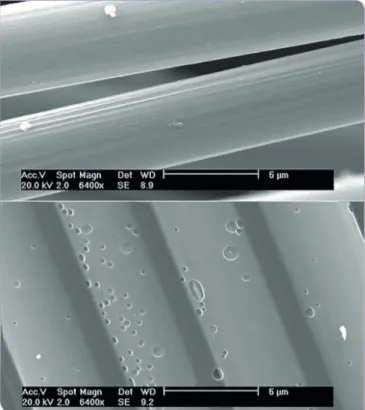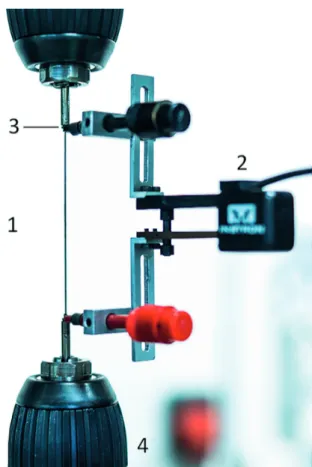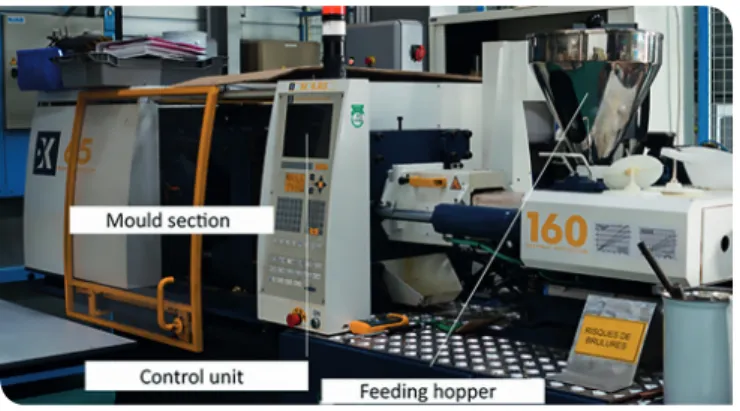HAL Id: hal-01691589
https://hal-mines-albi.archives-ouvertes.fr/hal-01691589
Submitted on 3 Nov 2020HAL is a multi-disciplinary open access
archive for the deposit and dissemination of sci-entific research documents, whether they are pub-lished or not. The documents may come from teaching and research institutions in France or abroad, or from public or private research centers.
L’archive ouverte pluridisciplinaire HAL, est destinée au dépôt et à la diffusion de documents scientifiques de niveau recherche, publiés ou non, émanant des établissements d’enseignement et de recherche français ou étrangers, des laboratoires publics ou privés.
Using steam thermolysis to recycle carbon fibres from
composite waste
Maxime Boulanghien, Serge da Silva, Florentin Berthet, Gérard Bernhart,
Yannick Soudais
To cite this version:
Maxime Boulanghien, Serge da Silva, Florentin Berthet, Gérard Bernhart, Yannick Soudais. Using steam thermolysis to recycle carbon fibres from composite waste. JEC Composites Magazine, JEC Group, 2015, p.68-70. �hal-01691589�
vapour which has been superheated at atmospheric pressure to degrade the organic matrix of a composite material. When applied to carbon fibre composites, it gives three products: a permanent gaseous fraction, a condensed gaseous fraction, and recycled carbon fibre.
Alpha Recyclage Composites worked on the initial research projects in partnership with the RAPSODEE process engineering research laboratory (“RAPSODEE” for “Laboratoire de Recherche d’Albi en génie des Procédés des Solides Divisés, de l’Énergie et de l’Envi-ronnement” at the Ecole des Mines in Albi, France). The goal was to apply steam thermolysis to aerospace-grade composite materials, given that the aircraft construction sector is a potentially large consumer of such materials.
Carbon fibre composites with RTM-6 matrices were treated using this new technology. We will not report on process parameters, as they are confidential. It was possible to eliminate high levels of resin (more than 99% by weight) without noteworthy change in the quality of the carbon fibres recovered. The same tests were carried
In this article, Alpha Recyclage Composites
presents a new steam thermolysis process to treat
carbon fibre composites for recycling. The
thermochemical process is used to recover the
carbon fibres, which are then recycled into new
thermoplastic compo-sites. These
second-generation materials possess mechanical
properties that are comparable to those of
materials made using virgin carbon fibres.
M. Boulanghien, ReseaRch engineeR,
s. Da silva, ReseaRch DiRectoR,
alpha Recyclage coMposites
F. BeRthet, ReseaRcheR,
g. BeRnhaRt, pRoFessoR,
univeRsitéDe toulouse, cnRs, Mines alBi, institut cléMent aDeR
y. souDais, lectuReR,
univeRsitéDe toulouse, cnRs, Mines alBi, centRe RapsoDee
Using steam thermolysis to recycle
carbon fibres from composite waste
R
egulations on composite waste management are becoming ever more restrictive. Carbon fibre composite recycling is still a relatively undeveloped market, however, even though the increasing use of carbon fibre materials means that the quantity of this type of waste will also rise significantly. For some years, the preferred method used to treat this new type of waste has been to separate the carbon fibre from the resin in order to reuse the fibre in new material formulations. Currently, the thermochemical processes studied the most for this type of separation are pyrolysis and solvoly-sis. Steam thermolysis, a hybrid solvolysis-thermolysis process is the technological solution developed by Alpha Recyclage Composites. This process produces recycled carbon fibres with their mechanical properties preserved.A new process to treat carbon fibre composites
Steam thermolysis is a thermochemical process that uses water
Fig. 1: SEM images of the surface of carbon fibres from RTM-6 composites treated by steam thermolysis (top) and pyrolysis (bottom) at the same temperature
Lyon) enabled the tensile testing of an entire carbon fibre tow. During the test, the fibres gradually break, with the load on each broken fibre being transferred to the bundle of unbroken fibres. The test lasts until all fibres in the tow have broken. The data analysis is based on the adjustment from a theoretical curve to the recorded experimental curve. The analytical model is based on out on these materials using pyrolysis in the absence of water, but
otherwise in the same operating conditions. While the fibres treated by steam thermolysis showed no signs of surface degradation, those treated by pyrolysis did (Figure 1), potentially leading to a loss of carbon fibre mechanical properties. The pyrolysis results also showed lower polymer degradation rates.
Figure 2 shows the thermogravimetric curves for degradation of the RTM-6 resin under pyrolysis and steam thermolysis. These comparative curves show the effect of water vapour on the kine-tics of polymer degradation. The Kissinger and Invariant Kinetic Parameters (IKP) methods were used to estimate the degradation activation energy under steam thermolysis and pyrolysis. The results showed that the degradation activation energy is always lower under steam thermolysis than under pyrolysis, underlining the importance of water vapour for reaction kinetics. The same studies have also been done on other types of resin, including thermoplastics, and the initial results will be presented at JEC Asia 2015 [1].
An unusual approach to measuring
the mechanical properties of recycled carbon fibres
The mechanical properties of recycled carbon fibres are usually measured using the single fibre tensile test (SFTT). However, the experimental setup for this test excludes testing large fibre popula-tions: given the strong natural heterogeneity of carbon fibres, the SFTT generates wide variability in the statistical parameters that are obtained from the test analysis, and therefore a low level of confi-dence. For this reason, the team worked with the MATEIS materials laboratory at the University of Lyon’s INSA Lyon applied science institute, using a different test to characterize these fibres [2]. The tensile test on a tow is a highly practical test that enables determining the average breaking strength of the thousands of fi-laments in a tow. The levels of confidence obtained are sufficiently significant, due to the extensive experimental database that was established. An ingenious experimental set-up (Figure 3) deve-loped by M. R’Mili from the University of Lyon (MATEIS-INSA
Fig. 2: Dynamic thermogravimetric curve for RTM-6 resin degradation under steam thermolysis and pyrolysis
Fig. 3: Photograph of a tow (1) of recycled carbon fibres under tensile stress. An extensometer (2) can be placed using the sleeves at each end (3). The tension grips are cylindrical (4)
Fig. 4: Tests on tows. Experimental and analytical load-strain curves for virgin and recycled carbon fibre. The difference recorded at maximum load is due to the difference in the number of filaments in the tows
from the composites (Figure 4). No degradation of the recycled fibre properties was observed: the virgin AS4C carbon fibre showed a breaking strength of 3864 MPa, compared to 3852 MPa for the recycled fibre. Thanks to the large database acquired with the tow tensile test, the confidence intervals over an average at 95% are very low at about 20 MPa.
Creating thermoplastic composites from recycled fibres
Virgin AS4C carbon fibres and the above recycled fibres were added to PA 6.6 matrices in a 6% fibre volume fraction. A Lab-Tech Engineering extruder (in partnership with the University of Pau – IPREM EPCP) and a DK-Codim injection press were used (Figure 5). The injected specimens were subjected to monotonic tensile tests (Figure 6). The mechanical tensile properties of the
composite made from recycled fibres (breaking strength: 136 MPa, elastic modulus: 8.4 GPa) are nearly identical to those of the composite made from virgin fibres (breaking strength: 141 MPa, elastic modulus: 8.9 GPa).
Conclusions and prospects
So far, the research programmes have shown the interest of steam thermolysis for the treatment of carbon fibre composites. Alpha Re-cyclage Composites would now like to demonstrate the industrial feasibility of such treatment. To this end, the “Rapid” programme, cofunded by the French Direction Générale des Entreprises and Direction Générale de l’Armement, has been set up in collaboration with the Institut Clément Ader (Mines d’Albi) to study new ways to develop composites from recycled carbon fibres. n
Acknowledgements The authors would like to thank the University of Lyon – MATEIS – INSA Lyon (France) and the University of Pau – IPREM- EPCP – Pau (France) for their scientific collaboration, and the French Environment and Energy Management Agency (ADEME) and the national technical research association ANRT for their financial support. References [1] A. Oliveira-Nunes, Y. Soudais: A steam-thermolysis process to recover carbon fibers from CFRP waste, JEC Asia 2015, Singapore, October 2015 [2] M. Boulanghien, M. R’Mili, G. Bernhart, F. Berthet, Y. Soudais: Fibre characterisation of steam thermal process recycled carbon fibre/epoxy composites, ICCM 19 proceedings, Montreal, 2013
[3] B.D. Coleman: On the strength of classical fibers and fiber bundles, Journal of the Mechanics and Physics of Solids, 7:60-70, 1958 [4] M. R’Mili, N. Godin, J. Lamon: Flaw strength distribution and statistical parameters for ceramic fibers: the normal distribution, Physical Review E, 85:1-6, 2012
More information: p.brosson@alpharecyclage.com
Focus
Alpha Recyclage Composites has been a partner of the Institut Clément Ader and the RAPSODEE research laboratory in Albi since 2009. Research has focused on the development of a steam thermolysis process to treat carbon fibre composite materials and on the corresponding manufacturing processes for recycling carbon fibres into second-generation materials. Thanks to the financial support of the Direction Générale des Entreprises and the Direction Générale de l’Armement, a pilot batch reactor for steam thermolysis (internal volume 2m3 or 2000 litres) and four
doctoral theses have been funded, including one that will start in October 2015.
Fig. 6: Stress-strain curves obtained for dry specimens and wet (1.02% moisture regain) specimens. Virgin fibre composites (a) and recycled fibre composites (b) Fig. 5: DK-Codim injection press


